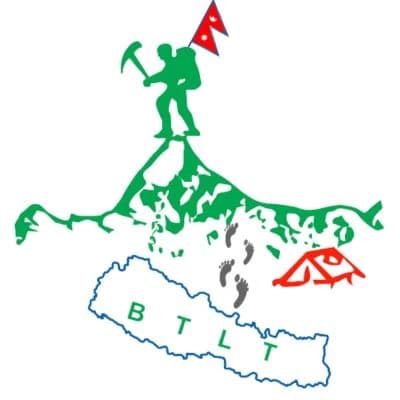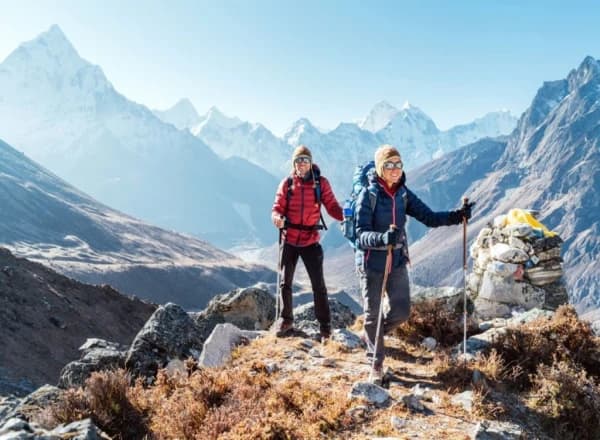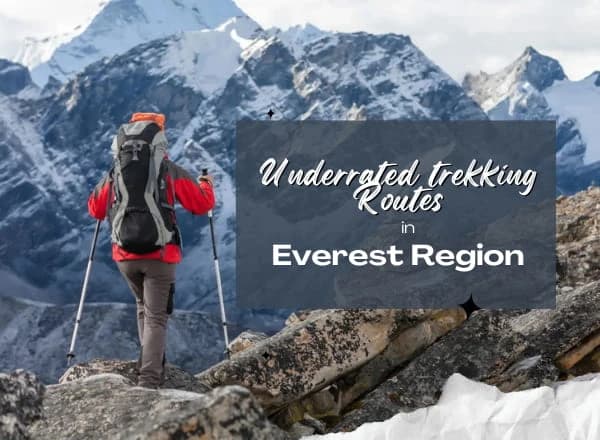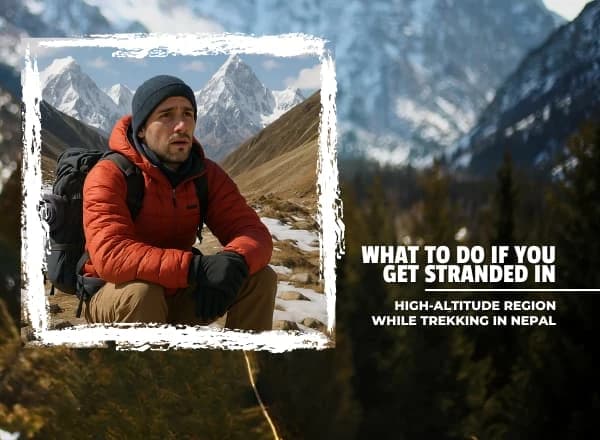Highlights:
- The Annapurna Circuit transforms into a serene landscape adorned with a shimmering blanket of snow.
- Winter offers a more solitary trekking experience, with notably fewer crowds than the peak seasons.
- December in the region is vibrant with local festivals and celebrations, providing a cultural immersion for trekkers.
- The crisp winter air ensures clearer skies, affording trekkers breathtaking views of the Himalayan peaks.
- With the tranquility of winter, trekkers stand a better chance of spotting the region’s elusive wildlife against the snowy backdrop.
- Nature showcases its beauty with frozen lakes and mesmerizing waterfalls that turn icy during the colder months.
- The winter trekking challenge fosters camaraderie among fellow trekkers, creating bonds and memories that last a lifetime.
- Local teahouses along the way offer a cozy retreat with warm drinks and traditional foods, enhancing the winter trekking experience.
- Trekkers witness unique flora and fauna, some of which are more visible or prominent during the winter season.
- The contrast of blue skies against the stark white snow offers photographers and nature lovers an unparalleled visual treat.
What is the Best Time to trek the Annapurna Circuit (ACT)?
The Annapurna Circuit Trek (ACT) is a jewel in Nepal’s trekking crown. It offers distinct experiences across different seasons. While each season has its charm, trekkers often seek the optimal balance between weather conditions and crowd density. Recognizing the best time for you can enhance the trekking experience multifold.
Spring in the Annapurna Circuit is a riot of colors. As winter recedes, the mountainsides are blanketed with blooming rhododendrons and wildflowers. The skies are generally clear, offering majestic views of the Himalayas. Temperatures are moderate, making it one of the most favored times for trekking.
Monsoon brings with it heavy rainfall, making trails slippery and challenging. However, the landscape turns lush green, and waterfalls are at their prime. While it might not be the best time for everyone, those seeking solitude and the raw beauty of nature often choose these months.
-
Autumn (September to November)
Regarded by many as the prime trekking season, Autumn offers clear blue skies, minimal rainfall, and moderate temperatures. The post-monsoon period ensures that the circuit is washed clean, presenting trekkers with crisp views of the snow-capped peaks.
-
Winter (December to February)
Winter presents a unique challenge with its colder temperatures and snow-laden paths, especially in higher altitudes. The Annapurna Circuit Trek in Winter, however, offers unparalleled beauty with snow-covered landscapes, fewer trekkers, and an overall tranquil experience. This is the time for those who seek adventure coupled with serenity.

Is It Possible to Trek the Annapurna Circuit in Winter?
While winter trekking in the Annapurna Circuit comes with its own set of challenges, it’s by no means impossible. It can be one of the most rewarding experiences for adventure seekers. The snowy landscapes, tranquil ambiance, and distinct beauty of the region during winter provide a unique backdrop that’s quite different from other seasons. With proper preparation, guidance, and gear, trekking the Annapurna Circuit in Winter can be an unforgettable journey.
Annapurna Circuit Weather in Winter:
The winter months in the Annapurna Circuit usher in a cold embrace. Daytime temperatures hover between 9°C to 12°C, but as the sun sets, it can go below freezing, especially at higher altitudes. Snowfall is common, and while it adds to the enchanting beauty of the landscape, it can also make certain trails slippery and challenging. Despite these cold conditions, the air is typically crisp and clear, offering spectacular views of the Himalayan peaks.
Difficulty of Annapurna Circuit Trek in Winter:
The Annapurna Circuit trek in Winter brings with it unique challenges compared to other seasons. The allure of snow-covered mountainsides is undeniably captivating, but trekkers must be prepared for the additional difficulties that winter presents. Successfully navigating the circuit during this season requires a blend of physical endurance, mental fortitude, and diligent preparation.
- Snow-Covered Trails:
The trails often become cloaked in snow, making them slippery and, at times, obscured. This increases the risk of missteps and requires trekkers to be constantly vigilant.
- Reduced Daylight:
Winter days in the Himalayas are noticeably shorter, pushing trekkers to start their days early and manage their trekking time wisely to ensure they reach their destinations before darkness falls.
- Altitude and Cold:
As one ascends, the challenges of high altitudes couple with plummeting temperatures. This combination can be especially demanding on the body, making proper acclimatization and warm gear essential.
- Varied Snow Conditions:
The snow’s consistency can change rapidly, from soft, powdery stretches to areas of hard ice. Each requires different techniques and precautions to traverse safely.
- Fewer Operational Teahouses:
Winter is off-peak for many teahouses, leading some to close for the season. This reduces the number of available stops for rest and refreshment, making advance planning crucial.
- Risk of Avalanches:
Particularly after heavy snowfall, certain sections of the trek might be at an increased risk of avalanches, necessitating trekkers to stay informed and opt for safer routes.
- Equipment Needs:
Winter trekking demands specialized equipment. Tools like crampons for better grip on icy paths and gaiters to keep snow out of boots become indispensable.
- Acclimatization:
The cold can intensify the effects of altitude sickness, making regular health checks and allowing the body adequate time to acclimatize even more critical.
- Restricted Mobility:
The need for heavier winter gear, combined with layered clothing, can somewhat limit a trekker's mobility. This can be particularly felt during steep climbs or when navigating tricky terrains.
- Isolation:
The charm of a less crowded trail comes with the flip side of potential isolation. The reduced number of fellow trekkers means fewer opportunities for social interactions, which, for some, can be mentally challenging.
Book your Annapurna Circuit Trek for Winter. Click here to send us an inquiry.
What Annapurna Circuit Trek Rewards You Within Winter?
Trekking the Annapurna Circuit in Winter is not just about overcoming challenges; it's about the unparalleled rewards that this unique season offers. The winter paints the Annapurna Circuit in hues and atmospheres that are distinct from any other time of the year, making every effort worthwhile. Here are the unmatched rewards one can expect during a winter trek.
- Serene Landscapes: Winter transforms the Annapurna Circuit into a dreamy realm. With snow draping the mountains, forests, and trails, the landscape adopts a serene and ethereal quality. This tranquility, coupled with the soft crunch of snow beneath your boots, provides a meditative trekking experience.
- Clear Skies and Unobstructed Views: The winter air, devoid of the dust and haze that can be prevalent in other seasons, provides crystal clear views of the Himalayan peaks. This clarity offers trekkers breathtaking vistas of the Annapurna range, making for unforgettable sunrise and sunset moments.'
- Cultural Immersion: Winter coincides with various local festivals and traditions. Trekking during this season provides travelers an opportunity to immerse themselves in local customs, witness traditional celebrations, and interact with the warm-hearted locals, fostering a deeper connection to the region.
- A Sense of Adventure: Navigating the challenges of winter adds an extra layer of adventure to the trek. Overcoming the elements, be it a snow-covered path or a particularly cold night, bestows a sense of achievement and satisfaction that's unique to winter trekking.
- Wildlife Encounters: The tranquility of winter and fewer trekkers can often mean better chances of spotting wildlife. From the vibrant Himalayan Monal to elusive snow leopards, winter offers the possibility of memorable wildlife encounters.
- Starry Nights: With clear winter skies come star-studded nights. Away from the light pollution of cities, the Annapurna Circuit provides a celestial showcase, offering trekkers a chance to indulge in some Himalayan stargazing.
- Unique Photographic Opportunities: For photography enthusiasts, winter brings about unique compositions. The contrast of white snow against dark rocks, frozen water bodies, and locals in their winter attire provide abundant opportunities to capture the essence of the Annapurna Circuit in winter.
- Bonding and Camaraderie: Facing and overcoming the challenges of winter together fosters a sense of camaraderie among trekkers. Sharing tales by the fireplace or helping one another during tough stretches creates bonds that often last a lifetime.
✔Know the complete breakdown of Annapurna Circuit Trek Cost

Things to Consider for Annapurna Circuit Trek in Winter:
While the Annapurna Circuit Trek in Winter can be one of the most rewarding experiences, it requires diligent preparation and careful consideration. The winter season brings about specific challenges and conditions that every trekker should be aware of. Knowing what to expect and how to navigate these unique situations can make all the difference in ensuring a memorable and safe journey.
- Specialized Gear and Clothing
In the face of freezing temperatures and snowy conditions, regular trekking gear won’t suffice. It'’s crucial to invest in or rent specialized winter trekking gear. This includes insulated boots, crampons for grip on icy surfaces, thermal clothing, and perhaps even snow goggles to protect against snow blindness. Layering becomes essential, and each layer should serve a purpose: wicking away moisture, insulating, and shielding against the elements.
Some parts of the circuit might be less accessible due to heavy snowfall or the risk of avalanches. It’s essential to stay updated about current trail conditions and be flexible with the route. Contact Us Beyond The Limit Treks, have the most up-to-date information and can advise on the safest paths.
- Health and Acclimatization
The cold can amplify the effects of altitude sickness. Trekkers should be extra cautious about monitoring their health, recognizing symptoms early, and ensuring proper acclimatization. Carrying medicines for common ailments and understanding first-aid basics can be life-saving.
Given the shorter days and potentially challenging conditions, trekkers might find themselves moving slower than expected. It’s wise to factor in extra days into the itinerary, ensuring there’s no need to rush and ample time for rest.
Hiring a local guide can be invaluable. They not only know the terrain and routes but also understand the intricacies of winter trekking in the region. Their expertise can provide insights into local customs, ensure better interaction with communities, and, most importantly, guide trekkers safely through the circuit.
Wrapping Up:
The Annapurna Circuit Trek in Winter is an expedition for the soul, blending raw beauty with a dash of adventure. While winter presents its own set of challenges, the rewards, from ethereal snowscapes to unparalleled serenity, make every step worth the effort. However, such a trek demands preparation, respect for nature, and a keen understanding of the environment. Beyond The Limit Treks is not just about guiding you through the trail but ensuring you are immersed in the essence of the journey. With our expertise, local insights, and unwavering commitment to your safety and satisfaction, choosing us means choosing an unforgettable and enriching Annapurna experience. Contact Us for local expertise in Annapurna Circuit Trek during winter. Click here to send us an inquiry.

Frequently Asked Questions About Annapurna Circuit Trek
1) Which season is best for the Annapurna Circuit trek?
✔ The best season for the Annapurna Circuit trek largely depends on personal preferences. Generally, the post-monsoon autumn months of September to November are considered optimal due to clear skies, moderate temperatures, and minimal rainfall. The pre-monsoon spring season, from March to May, is also popular because of the blooming rhododendrons and relatively stable weather. However, each season offers its own unique experiences and challenges.
2) Can you do the Annapurna Circuit in December?
✔ December is the beginning of the winter season in this region and its is possible to Trek this time. While you’ll encounter colder temperatures and possible snowfall, especially at higher altitudes, December offers clearer skies, fewer crowds, and a tranquil ambiance. Proper preparation and gear are essential to ensure safety and comfort during the trek.
3) Can you hike the Annapurna Circuit in January?
✔ January is the peak of winter in the Annapurna region. Trekking the Annapurna Circuit during this month is possible but comes with challenges like heavy snowfall, especially in higher altitudes, and extremely cold temperatures. Some sections of the trek might be less accessible. However, with the right equipment, guidance, and a resilient mindset, January can provide an unparalleled serene winter trekking experience.
4) Which month is best for the Annapurna Base Camp trek?
✔ The Annapurna Base Camp trek is best undertaken during the autumn months of September to November or the spring months of March to May. Autumn offers clear skies, minimal rain, and temperate weather, while spring brings colorful blooms and relatively stable weather conditions. Both these seasons ensure spectacular views and a comfortable trekking experience.
Want to Customize Your Trip Now!
Talk directly with Expert











